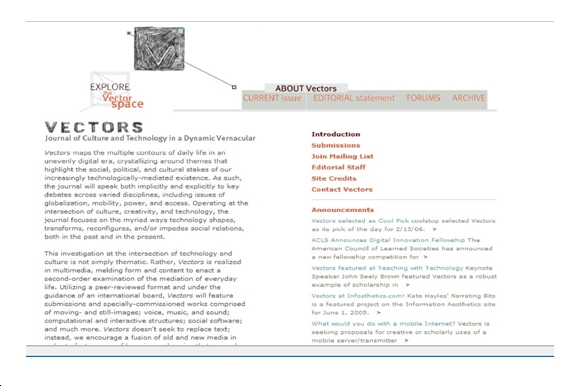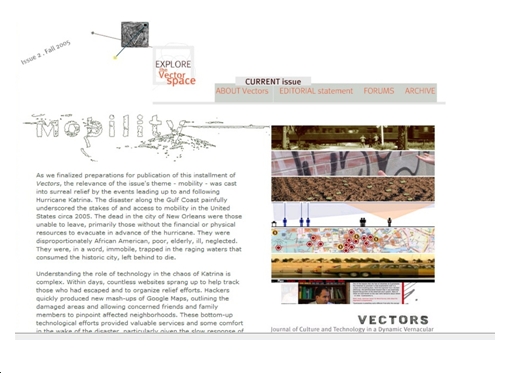Related Categories: Online Journals (experimental paradigms), New Approaches to Reading Print Texts, Text Visualization, New Reading Interfaces
Summary:
Vectors is an online journal that embraces the Internet as the space for embracing and engaging critical experimentation and collaboration on topics related to and inspired by its digital environment.
Description:
First launched in 2005, Vectors is a new experiment and is available online at http://vectors.iml.annenberg.edu/. In its short tenure, the journal has already become a central force and centralized space for discourse across a variety of disciplines. Published out of the University of Southern California, the journal is edited by Tara McPherson with Steve Anderson as Associative Editor. Creative Directors Erik Loyer and Raegan Kelly and User Interface Engineer Craig Dietrich are responsible for its evolutionary aesthetic and interface. Its editorial board is international, cross-disciplinary, and prestigious.

Each issue contains a variety of projects and perspectives that cumulatively display a slice of contemporary research and innovation into digital technologies and their influences. Connected under such open topics and titles as “Mobility,” the selected works exhibit interesting intersections across disciplines and technologies. Some of the projects, Todd Presner’s impressive “Hypermedia Berlin” project for example, are themselves major, emergent projects worthy of distinction and display. Their inclusion in Vectors makes the journal both an important focal point for charting the development of such evolving projects and for connecting these large-scale visions to other nodes in the networked landscape of digitally-focused work.
Its first two issues “Mobility” and “Evidence” included such diverse projects as David Salz’s Virtual Vaudeville, an innovative and inspiring use of digital technologies to archive and bring to life American vaudeville theater at the turn of the 20th century; a beautifully-designed archived experience of an original museum exhibition of Jenny Holzer’s work, “Jenny Holzer at the Neue Nationalgalerie,” by Gwen Allen and Ehren Fordyce; and a critical article, “Narrating Bits,” by literary scholar N. Katherine Hayles that visualizes the text and allows the reader to interact with it as well as post messages about its content on the Vectors’s site.
The journal not only publishes innovative work but also helps enable its production. USC’s Institute for Multimedia Literacy supports the Vectors Summer Fellowship Program, which helps “foster innovative research” for publication in the journal.
Research Context:
Vectors is of immediate interest to the Transliteracies project as it is to anyone interested in “the social, political, and cultural stakes of our increasingly technologically-mediated existence.” As its mission statement explains,
“the journal will speak both implicitly and explicitly to key debates across varied disciplines, including issues of globalization, mobility, power, and access. Operating at the intersection of culture, creativity, and technology, the journal focuses on the myriad ways technology shapes, transforms, reconfigures, and/or impedes social relations, both in the past and in the present.”
In addition to the contents in its “pages,” however, Vectors itself is part of the emerging research context of changes in reading. Its practice of pairing authors and designer propels collaboration and places its webspace as a place for experimentation and research into the possibilities of reading and writing online.
Technical Analysis:
Vectors is an online journal, and it requires Flash Player 7 to access its website. Each issue of the journal contains a frontpage that contains an editorial introduction and represents the works as part of a visual patchwork quilt.

Clicking on one of the rectangular images, the reader enters the portal page for the individual project wherein the editors supply an introduction tailored to the piece. From this page, the reader read statements by the author, designer, or other collaborators; or, the reader can then launch the project.
Evaluation of Opportunities/Limitations for the Transliteracies Topic:
In addition to the individual projects highlighted by the journal, the intersections across and between them–the vectors illuminated by Vectors–that are of vast interest and inspiration for a variety of artists, critics, and programmers. The journal can thus be read for its contents and for its constitution: it is itself an important project and point of departure for mapping the changing contexts for critical engagement with new media. In other words, Vectors is displays how innovative critics and artists read their contemporary moment through digital technologies. Vectors also makes evident how innovations in publishing use digital technologies to promote connections between the various vectors shaping intellectual intersections across disciplines and geographies.
Resources for Further Study:
- Vectors: Journal of Culture and Technology in a Dynamic Vernacular
- Interview with editor Tara McPherson about Vectors. 22 minute recording.
